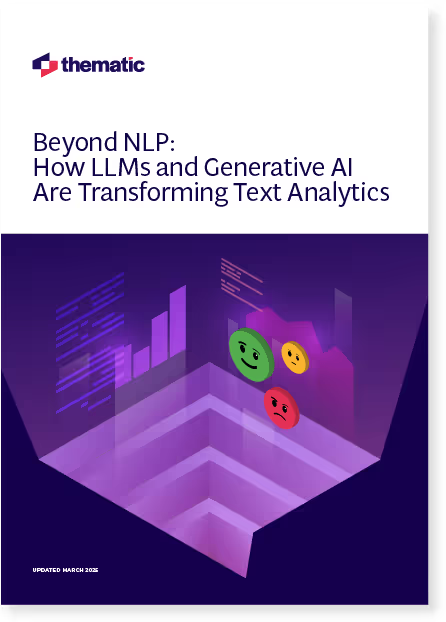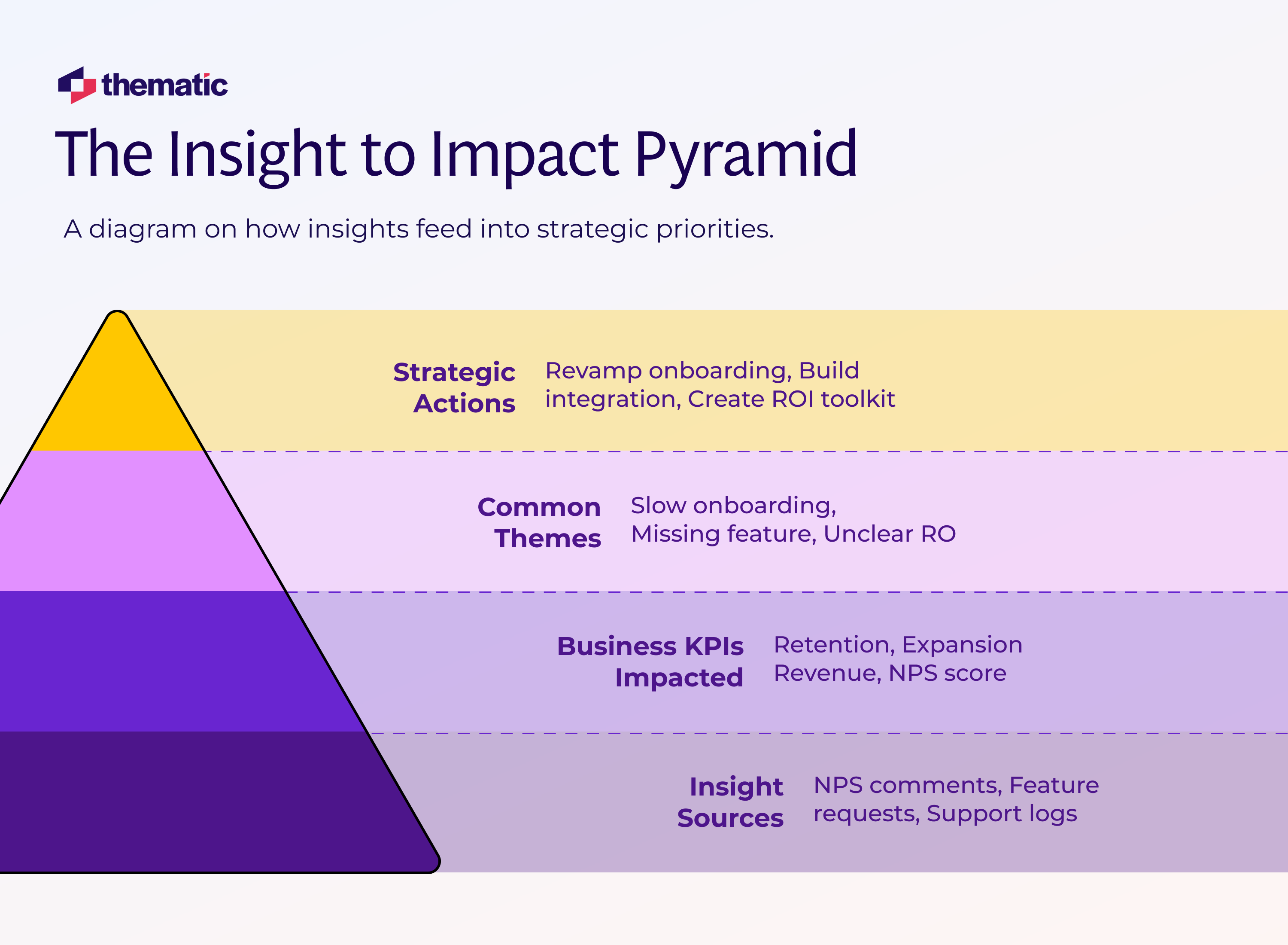
Learn how B2B customer insights help businesses understand client needs, improve engagement, and drive long-term relationships.

Understanding your B2B customer insights means learning what makes your business clients tick—their needs, behaviors, pain points, and goals—through data. Unlike with B2C, where you get insights from individuals, in B2B, you get insights from an entire organization, often with multiple stakeholders involved in decisions. So, a B2C retailer might analyze one shopper’s buying habits, whereas a B2B company must understand a client account with multiple stakeholders and longer purchase cycles.
That said, with B2B customer insights, stakes are higher, and relationships more complex.
But its importance can’t be overstated: a recent survey found customer insight is the most critical skill for B2B marketers’ success (cited by 54% of respondents). Why? Because keeping business clients happy is far more cost-effective than constantly chasing new ones (it can cost five times more to acquire a new customer than to retain an existing one).
In short, understanding your B2B customers deeply isn’t a nice-to-have—it’s fundamental for engagement, loyalty, and growth.
And we’re going to talk about how to do that here.
Yes, you need data-driven customer insights, but not just any data. When you put together a customer insights strategy, you need the right data.
B2B companies have rich data sources that go beyond basic surveys. Make sure you’re collecting feedback and information from all key sources:
| Data Source | What It Reveals |
|---|---|
| CRM & Account Records | Historical context, account health, sales cycle length, renewal status, commitments |
| Customer Success Notes / QBRs | Executive sentiment, strategic goals, feedback from decision-makers and users |
| Onboarding & Training Feedback | Early experience, ease of adoption, training effectiveness, initial pain points |
| Support Tickets & Chat Logs | Recurring issues, product friction points, urgency of problems, support satisfaction |
| Product Usage Data | Adoption trends, feature popularity, engagement health, expansion potential |
| VoC Interviews / Focus Groups | Qualitative insights, unmet needs, emotional drivers, improvement suggestions |
This table can help B2B teams align on which data source to prioritize based on what questions they’re trying to answer (e.g., “Why are onboarding scores low?” → look at onboarding feedback + CRM activity). Let me know if you'd like this adapted into a visual slide or design format, too!
Importantly, capture feedback in context.
B2B feedback isn't one-size-fits-all—it varies by account type, size, and role. A comment from a small startup client might carry a different weight than the same comment from a Fortune 500 client.
Segment and tag your data (e.g., by industry, customer tier, or lifecycle stage) so you can interpret it correctly.
For example, a complaint from a newly onboarded customer could indicate a training issue, while the same complaint from a long-term customer could signal a recent regression. Remember that in B2B, the “customer” is the entire organization, not just one end user. That means you may need feedback from multiple levels—executives, managers, and day-to-day users—to see the full picture of an account’s experience.
By capturing contextual data (such as which product the customer uses, or what stage of the customer journey they’re in), you interpret feedback more accurately.
One tip is to integrate your data sources—bring together survey results, CRM records, and support data so you can correlate them.
Modern customer feedback platforms, like Thematic, make this easier by integrating data from surveys, chat logs, online reviews, and more—fusing it all with your performance metrics to yield deeper, actionable insights. When you unify all this information, patterns start to emerge that any single source alone might miss.
Once you have robust data coming in, the next challenge is making sense of it. B2B customer insights analysis should focus on the metrics and signals that drive retention and growth. This is where customer analytics comes into play—examining the data to spot trends, risks, and opportunities. The best customer insights platform can do this without a hitch.
Now, keep in mind how B2B customers differ from individual consumers in analysis: instead of just tracking one person’s behavior, you’re often tracking a whole account’s health. That means looking at aggregated indicators (like overall product adoption rates across a client company, or the sentiment of all their user feedback) as well as key stakeholder satisfaction.
In the B2B world, losing one client can have a big impact, so predicting and preventing churn is a top priority. Analyze patterns that typically precede churn: for example,
If a high-value client’s usage drops for two months in a row and their support tickets spike, that’s a red flag worth investigating immediately.
Using analytics, you can even assign health scores to accounts based on these factors and set up alerts when an account looks at-risk. Companies that excel here tie these insights directly to outcomes—for instance, they know that improving an account’s engagement can directly improve renewal odds. Research consistently shows retention is hugely profitable: even a 5% improvement in customer loyalty can translate to 25–95% higher profits.
The volume and complexity of B2B feedback can quickly overwhelm manual analysis—imagine coding qualitative data from multiple sources manually. This is where AI in customer insights analysis becomes really useful.
AI-driven text analytics can read through open-ended responses, emails, and chat transcripts far faster than any human, and do it 24/7. It’s not just speed—AI can also detect patterns that are easy to miss. For example, it might notice that complaints about a certain feature are rising before your support team flags it.
AI (like natural language processing, especially the more advanced large language models) categorizes feedback into themes, gauges sentiment (positive/negative tone), and even picks up emerging topics.
Atlassian—a B2B software company—faced an overwhelming amount of user feedback coming in from multiple channels. They turned to AI-powered text analytics to handle this scale.
Using NLP, Thematic’s system automatically categorized Atlassian’s customer comments, detected sentiment trends across accounts, and identified recurring pain points. As such, Atlassian quickly pinpointed the issues affecting many clients at once and prioritized fixes. The result was a faster response to customer concerns and more targeted product improvements. In short, AI took a mountain of unstructured feedback and distilled it into clear, actionable insights.
Is your Text Analytics solution still relying on B-Grade NLP? Discover how large language models are revolutionizing text analytics, offering deeper insights than traditional NLP approaches.

But remember that AI isn’t just about finding problems—it also discovers opportunities.
It might reveal, for example, that many customers are asking for an integration with a certain tool, indicating a potential feature to develop. Or it could uncover that customers who use Feature X heavily are also those with the highest renewal rates, suggesting you should encourage other clients to adopt that feature.
These are insights that lead directly to proactive strategies: preventing churn, upselling new solutions, or doubling down on what’s working.
As you analyze, always tie findings back to “so what?”—what action will this insight inform?
A simple way to visualize this is a Feedback → Insight → Action flow.

By focusing on the analytics that answer business-critical questions—like what drives churn, what increases usage, what improves satisfaction—you ensure you’re not just generating reports, but insights that your team can act on.
Of course, once you have analyzed the data, you don’t leave it just at that. To truly improve customer outcomes and your own business results, you need to act on those insights. Here are key ways to put B2B customer insights into action:
Chart out your customer's lifecycle from onboarding to renewal, and use insights at each step to enhance their experience. For example, if onboarding feedback reveals confusion about a feature, improve your training or documentation right away.
Later in the journey, monitor usage and sentiment data—if you spot a downturn in engagement, intervene with support or education before a small issue becomes a reason to churn.
An annotated journey map that shows where to gather feedback and take action ensures no stage is overlooked, and clients feel heard every step of the way.
| Stage | Insight Source | Example Insight | Action Taken |
|---|---|---|---|
| Onboarding | Survey + CRM activity logs | Users confused about Feature X | Revise training materials, add tooltips |
| Adoption | Product usage data | Low engagement with high-value feature | Trigger success manager outreach |
| Support | Ticket trends + sentiment | Spike in complaints about slow response times | Add weekend support coverage |
| Expansion | Feature request patterns | Clients asking for integration with Tool Z | Prioritize in roadmap, notify relevant clients |
| Renewal | NPS + QBR feedback | Executive sponsor not seeing ROI | Present usage impact report before renewal meeting |
B2B insights aren’t just for the post-sale team; they can loop back into how you win and communicate with customers.
Analyze your customer interactions to refine your approach. For instance, if you notice prospects often ask for certain information during the sales process, marketing can create content to address it upfront.
If analysis of closed deals shows that a particular product benefit resonates strongly in a certain industry, your sales team can double down on that message for similar prospects.
Customer feedback can even reveal new use cases or value propositions that shape your marketing campaigns.
By basing decisions on research insights (not gut feeling), your outreach becomes more relevant to your target audience. In short, let data on what current customers love (or struggle with) inform how you attract new customers.
| Insight Source | Insight Example | Marketing/Sales Response |
|---|---|---|
| Win/loss analysis | Competitor feature mentioned often | Train sales on objection handling |
| Sales call transcripts | Prospects ask for security documentation | Create a downloadable resource |
| Industry-segmented NPS feedback | Financial services clients value speed-to-deploy | Focus messaging on rapid implementation |
| Feedback from early users | Customers using Product X for an unexpected use case | Highlight this use case in future campaigns |
Every business client wants to feel understood. Use your insights to tailor the experience for each account or segment. This could mean segmenting customers by size or industry and customizing your engagement for each group—e.g., sending enterprise clients a different onboarding package than SMB clients based on their different needs.
On an account level, track each client’s goals and preferences (often recorded in success plans or CRM) and act on them. If you know a particular client values quick response times the most, prioritize that in your support and check-ins.
Or if an account’s customer data shows they only use 3 of the 10 available modules of your product, provide recommendations or training targeted to the areas they haven’t explored.
Personalization shows the customer that you “get” them. In fact, an overwhelming majority of B2B customers expect this—86% of B2B buyers expect companies to be well-informed about their business needs and personal information during interactions.
By demonstrating that you remember their context (past issues, key objectives, etc.), you build trust and loyalty. Insight-driven personalization can be the difference between a one-size-fits-all relationship and a true partnership.
| Customer Segment | Insight Collected | Personalization Example |
|---|---|---|
| Enterprise clients | Long onboarding ramp-up | Assign dedicated CSM, offer custom workshops |
| SMBs | Fast feature adoption, limited support needs | Use light-touch success automation |
| Usage underperformers | Only using 30% of licensed features | Provide targeted training and reminders |
| ROI-focused executives | Requests for KPI tracking | Share usage impact reports during QBRs |
Ensure that the customer insights you focus on are linked to your company’s objectives. This keeps your program outcome-driven. For example, if your goal is to improve retention by 10%, identify which metrics and feedback categories correlate with retention (maybe response time on support, or product adoption rates). Set up those as your key performance indicators and track them religiously.
Likewise, if a strategic goal is expanding usage in existing accounts, pay close attention to feature request trends or usage patterns in feedback.
Every insight initiative should answer, “How will this help us reduce churn, increase revenue, or improve satisfaction?”
When setting up your VoC or insights strategy, define clear success criteria. You might say, “Our objective is to raise our NPS by 10 points this year by addressing the top 3 customer pain points identified in feedback.” That objective is specific and tied to a business outcome (NPS links to loyalty). It guides the team’s efforts and provides a measure of progress.
Crucially, communicate these links across the organization. When everyone sees that acting on insights leads to tangible improvements—say, higher NPS leading to a predicted uptick in renewals—it reinforces an insights-driven culture. As one guide advises, tie your customer insight goals to concrete business KPIs (e.g., improve onboarding satisfaction to boost 90-day retention by X%) so that the value of insights is clear to all.

B2B customer insights are not a luxury—they're essential for a winning strategy. By collecting the right data, analyzing key trends, and acting on feedback, you turn customer voices into tangible improvements.
This cycle helps you fix issues faster, tailor your service, and make more informed decisions to continuously deepen each client relationship.
Over time, you earn trusted-partner status with your clients—leading to higher retention, more upsell opportunities, and a stronger reputation. In a competitive market, companies that truly understand and respond to their B2B customers’ needs are the ones that win loyalty for the long haul.
Ready to gather customer insights and experience feedback analysis in action on your own data? Request a demo of Thematic now!
Join the newsletter to receive the latest updates in your inbox.